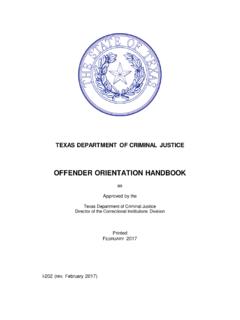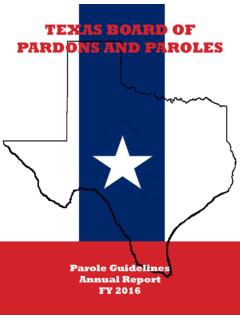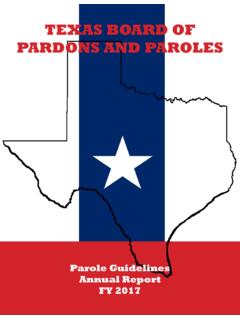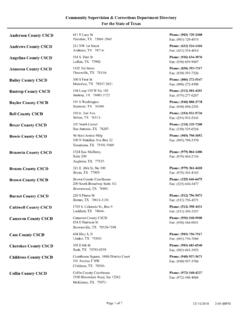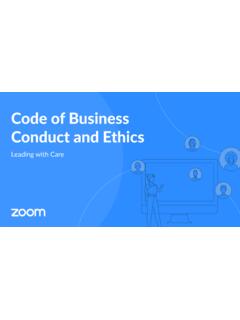Transcription of Excerpt from PD-22, - Texas Department of Criminal Justice
1 Texas Department OF Criminal Justice Excerpt from PD-22, general rules of conduct and disciplinary Action Guidelines for Employees (rev. 17) November 1, 2021 Prepared by Human Resources Support Operations PD-22 (rev. 17) Excerpt Page 1 of 23 (11/21) INTRODUCTION: This handbook is an Excerpt from PD-22, general rules of conduct and disciplinary Action Guidelines for Employees. All references to this directive refer to PD-22. If you would like to review PD-22 in its entirety, you may contact your human resources representative.
2 PD-22 is also available on the TDCJ intranet and on the TDCJ website at POLICY: Employees are representatives of the Texas Department of Criminal Justice (TDCJ) and are expected to adhere to the highest standards of conduct while on-duty or off-duty, including adherence to the rules of conduct as published and described in PD-22, Attachment A, listing of employee general rules of conduct and disciplinary violations . Employees who allegedly commit a rule violation will be subject to disciplinary action in accordance with the procedures within this directive.
3 The TDCJ promotes equal employment opportunity through an employee disciplinary system designed to impose disciplinary actions without regard to race, color, religion, sex (gender), national origin, age, disability or genetic information (collectively, protected class ). The TDCJ has a zero tolerance for all forms of employment discrimination in the disciplinary process. Retaliation for opposing or reporting employment discrimination is prohibited. EMPLOYMENT AT WILL CLAUSE: This directive does not constitute an employment contract or a guarantee of continued employment.
4 The TDCJ reserves the right to change the provisions of this directive at any time. Nothing in this directive limits the executive director s authority to establish or revise human resources policy. This directive guides the operations of the TDCJ and does not create a legally enforceable interest for employees or limit the executive director s, deputy executive director s, or division directors authority to terminate any employee at will. DISCUSSION: I. employee s Responsibility to Know rules and Regulations It is an employee s responsibility to know the rules in this directive and to seek clarification, if necessary.
5 Being unaware of the existence of any of the rules is not a defense for violations . No single document can anticipate or address every situation. Therefore, an employee should maintain knowledge of other current TDCJ directives and standard operating procedures. In the event no written or verbal instructions have been issued regarding an employee s responsibilities or duties, the employee is expected to use sound judgment in arriving at a prudent course of action. II. Corrective Actions Other than disciplinary Actions (Content of Section II is not included in this Excerpt .)
6 PD-22 (rev. 17) Excerpt Page 2 of 23 (11/21) III. Grievance of disciplinary Action disciplinary action may be grieved in accordance with PD-30, employee Grievance Procedures. Dismissal recommendations or alleged procedural violations in connection with a dismissal recommendation may be grieved only after a final decision is rendered by the executive director, deputy executive director, appropriate division director, or an Equal Employment Opportunity Designated Agency Official (EEO-DAO).
7 IV. Actions by Other Agencies or Entities (Content of Section IV is not included in this Excerpt .) listing OF employee general rules OF conduct AND disciplinary violations These rules specify the conduct required of a TDCJ employee . DEFINITIONS: The following definitions apply solely to the rule violations . Conviction is: (a) a finding of guilt by judge or jury and the assessment of punishment, whether confinement or fines; (b) community supervision (probation), including deferred adjudication; (c) a juvenile adjudication of delinquent conduct if the juvenile records are not sealed; and (d) an equivalent disposition of an offense under the laws of another state, federal law, or Uniform Code of Military Justice .
8 The term does not include a pretrial diversion, which is an agreement between the defendant and prosecutor and occurs before a judicial finding, although a judge may approve of the defendant participating in the program. Pardons or reprieves do not eliminate a conviction. Discourteous conduct of a Sexual Nature is conduct , in words or actions, of a sexual nature toward or witnessed by another TDCJ employee or other individual (see definition for Other Individual ) that: (a) a reasonable person would find offensive; or (b) is unwelcome to the person to whom such conduct is directed and that person has communicated, by words or actions, to the other person that the conduct is unwelcome.
9 Discrimination is unequal treatment of persons based on a protected class, including sexual harassment. Discrimination by employers falls into four general areas: (1) hiring and firing, such as failing or refusing to hire, or discharging; (2) employment conditions, such as compensation, terms, conditions, or privileges; (3) segregation and classification, such as limiting, segregating, or classifying employees in any way that would deprive or tend to deprive any individual of employment opportunities or otherwise adversely affect their status as an employee .
10 And (4) training, such as unequal access to training that may affect an individual s ability to promote. employee is any person employed by the TDCJ on a full-time, part-time, or temporary basis. Harassment is systematic or continued unwanted actions, including threats and demands, directed toward an employee or other individual that may create a hostile work environment for the person to whom the acts are directed. PD-22 (rev. 17) Excerpt Page 3 of 23 (11/21) Hazing is conduct that intentionally subjects another person to embarrassment, intimidation, or ridicule and risks emotional and/or physical harm.

